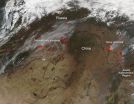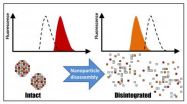(Press-News.org) WHAT: National Institutes of Health (NIH) researchers have developed an animal model of human hantavirus pulmonary syndrome (HPS) in rhesus macaques, an advance that may lead to treatments, vaccines and improved methods of diagnosing the disease. The study, conducted by researchers at NIH’s National Institute of Allergy and Infectious Diseases (NIAID), is published in the Proceedings of the National Academy of Sciences.
People become infected with hantaviruses by inhaling virus from the urine, droppings or saliva of infected rodents. This infection can progress to HPS, a severe respiratory disease that was first identified in 1993 in the southwestern United States. HPS attained global attention in the summer of 2012 when physicians diagnosed 10 cases—three of them fatal—in Yosemite National Park in California. The primary HPS agents are Sin Nombre virus in North America and Andes virus in South America. Since 1993, the Centers for Disease Control and Prevention has reported approximately 600 HPS cases, including 200 deaths, in the United States; case numbers for South America are not available.
In their study, NIAID scientists infected healthy deer mice with Sin Nombre virus obtained from descendants of wild deer mice. The researchers then exposed 10 rhesus macaques to the virus derived from the newly infected deer mice. Nine monkeys became infected and seven developed severe disease. In the diseased macaques, researchers observed how and where the virus established infection, evaded the immune system and caused pneumonia. Of note, they report that, similar to hantavirus infection in people, the virus in the monkey model triggers a life-threatening immune response nearly two weeks after infection. NIAID researchers aim to identify biological markers during that initial timeframe that may be useful for early diagnosis.
ARTICLE: Safronetz et al. Pathophysiology of hantavirus pulmonary syndrome in rhesus macaques. Proceedings of the National Academy of Sciences DOI: 10.1073/pnas.1401998111 (2014).
WHO: NIAID Director Anthony S. Fauci, M.D., is available for interviews. David Safronetz, Ph.D., of NIAID’s Laboratory of Virology, also is available.
CONTACT: To schedule interviews, please contact Ken Pekoc, (301) 402-1663, kpekoc@niaid.nih.gov.
INFORMATION:
NIAID conducts and supports research—at NIH, throughout the United States, and worldwide—to study the causes of infectious and immune-mediated diseases, and to develop better means of preventing, diagnosing and treating these illnesses. News releases, fact sheets and other NIAID-related materials are available on the NIAID Web site at http://www.niaid.nih.gov.
About the National Institutes of Health (NIH): NIH, the nation's medical research agency, includes 27 Institutes and Centers and is a component of the U.S. Department of Health and Human Services. NIH is the primary federal agency conducting and supporting basic, clinical, and translational medical research, and is investigating the causes, treatments, and cures for both common and rare diseases. For more information about NIH and its programs, visit http://www.nih.gov.
NIH...Turning Discovery Into Health®
NIH scientists establish monkey model of hantavirus disease
2014-04-28
ELSE PRESS RELEASES FROM THIS DATE:
A water test for the world
2014-04-28
HAMILTON, April 28, 2014 – Inspiration can come in many forms, but this one truly was a breath of fresh air.
A group of McMaster researchers has solved the problem of cumbersome, expensive and painfully slow water-testing by turning the process upside-down.
Instead of shipping water to the lab, they have created a way to take the lab to the water, putting potentially life-saving technology into the hands of everyday people.
The team has reduced the sophisticated chemistry required for testing water safety to a simple pill, by adapting technology found in a dissolving ...
Technological advancements extend survival of transplanted hearts across species
2014-04-28
The use of transplant organs from animals (xenotransplantation) could help to compensate for the shortage of human organs available for transplant. NIH researchers have demonstrated that by using hearts from genetically engineered pigs in combination with target-specific immunosuppression of recipient baboons, organ survival can be significantly prolonged. This has potential for paving the way for the use of animal organs for transplantation into humans.
Toronto, ON, Canada, April 28, 2014 – Cardiac transplantation is the treatment of choice for end stage heart failure. ...
Disney Researchers use 3-D printing to produce interactive speakers of any shape
2014-04-28
Forget everything you know about what a loudspeaker should look like. Scientists at Disney Research, Pittsburgh have developed methods using a 3D printer to produce electrostatic loudspeakers that can take the shape of anything, from a rubber ducky to an abstract spiral.
The simple speakers require little assembly, but even those few manual steps might be eliminated in the future, said Yoshio Ishiguro, a Disney Research, Pittsburgh post-doctoral associate. "In five to 10 years, a 3D printer capable of using conductive materials could create the entire piece," he predicted.
The ...
Well-informed patients key to accepting gene-based drug dosing
2014-04-28
A new study out of Western University (London, Canada) illustrates the need for a lot more education around pharmacogenetics (PGx) –the study of how a patient's genes can affect drug reaction and dosage. PGx promises to optimize patient response to therapy, but this is the first study to really investigate how patients perceive this kind of genetic testing, and whether those perceptions differ when it comes to parents and their children. The research, led by Dr. Michael Rieder of Western's Schulich School of Medicine & Dentistry is published in the journal Pediatrics.
"Pharmacogenetic ...
The thin-crusted US Sierra Nevada Mountains: Where did the Earth go?
2014-04-28
Boulder, Colo., USA – In an addition to Geosphere's ongoing themed issue series, "Geodynamics and Consequences of Lithospheric Removal in the Sierra Nevada, California," Craig H. Jones of the University of Colorado Boulder and colleagues examine the seismological study of the entire extent of the U.S. Sierra Nevada range using seismograms collected in the Sierra Nevada EarthScope field experiment from 2005 to 2007.
The southern Sierra Nevada is known to have unusually thin crust for mountains with such high elevations (peaks higher than 4 km/14,000 ft, and average elevations ...
Precise brain mapping can improve response to deep brain stimulation in depression
2014-04-28
Experimental studies have shown that deep brain stimulation (DBS) within the subcallosal cingulate (SCC) white matter of the brain is an effective treatment for many patients with treatment-resistant depression. Response rates are between 41 percent and 64 percent across published studies to date.
One of the proposed mechanisms of action is the modulation of a network of brain regions connected to the SCC. Identifying the critical connections within this network for successful antidepressant response is an important next step.
A new study using MRI analysis of the ...
Wildfire outbreak in far eastern Russia
2014-04-28
According to the Voice of Russia, "As of Saturday morning, in Russia continue 103 wildfires at 27,412 hectares, including big 26 wildfires in the Far East and in Siberia. On Friday, 147 new fires began at 12,509 hectares, and 150 were extinguished at 5,437 hectares. Emergency situation has been introduced in the regions with most complicated situations - in the Amur region, in the Maritime and Baikal territories. This was according to the EMERCOM's (Emergency Control Ministry) spokesperson Alexander Drobyshevsky.
Satellites (such as Aqua and Terra) have located "1,587 ...
Cyberspace scholarship nets higher grades, better thinking for class Facebook group
2014-04-28
University students who used a Facebook group as part of a large sociology class did better on course assignments and felt a stronger sense of belonging, according to a Baylor University study.
The study has implications for the challenge of teaching large classes, a growing concern for higher education. Classes numbering hundreds of students — particularly in introductory courses — have become common at many universities, said researchers Kevin Dougherty, Ph.D., associate professor of sociology in Baylor's College of Arts and Sciences, and Brita Andercheck, a doctoral ...
Newborn Tropical Storm Tapah threatens Saipan and Tinian
2014-04-28
A tropical storm warning is in force for Saipan and Tinian as Tropical Storm Tapah moves north through the Northwestern Pacific Ocean on April 28. When NASA-NOAA's Suomi NPP satellite passed overhead and, imagery revealed a developing eye in Tapah.
In addition to the tropical storm warning, a typhoon watch is in effect for Alamagan and Pagan as Tapah is expected to continue in a generally northerly direction over the next couple of days. A typhoon watch means typhoon force winds of 74 mph or greater are possible within 48 hours. A tropical storm warning means tropical ...
Fluorescent-based tool reveals how medical nanoparticles biodegrade in real time
2014-04-28
Nanoparticles have been heralded as a potential "disruptive technology" in biomedicine, a versatile platform that could supplant conventional technologies, both as drug delivery vehicles and diagnostic tools.
First, however, researchers must demonstrate the properly timed disintegration of these extremely small structures, a process essential for their performance and their ability to be safely cleared out of a patient's body after their job is done. A new study presents a unique method to directly measure nanoparticle degradation in real time within biological environments.
"Nanoparticles ...





